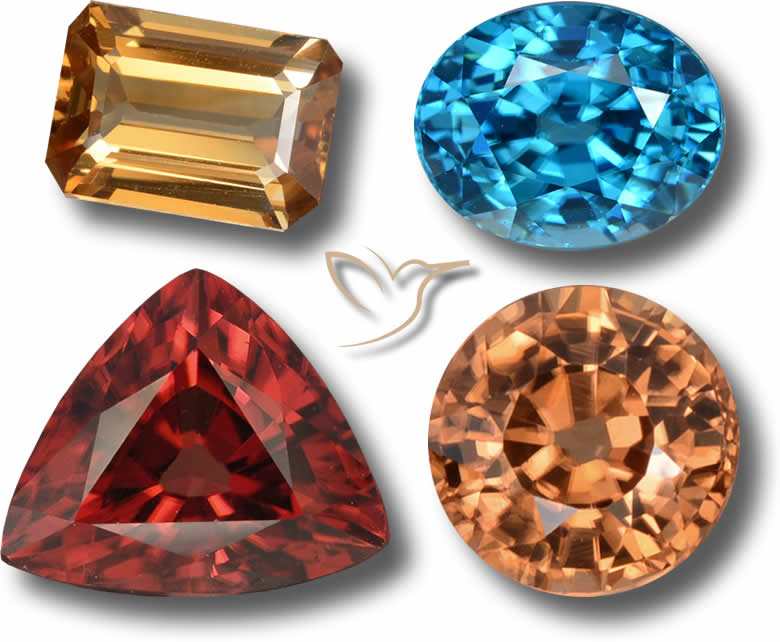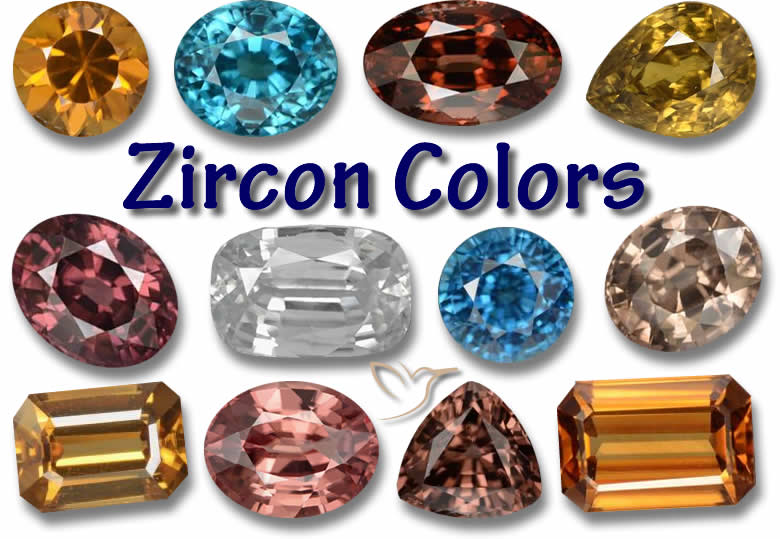Zircon Gemstone Information

Zircon stands out as one of the oldest minerals known, with ties to both human history and the Earth's ancient past. A zircon crystal discovered in Australia back in 2014 dates back almost 4.5 billion years, making it nearly as old as our planet. In biblical times, a type of zircon called hyacinth or jacinth appeared among the 12 stones of Israel, and Hindu legends describe a mythical tree adorned with zircon gems.
Over time, zircon's reputation has taken a few hits. It was once used in its clear form as an affordable stand-in for diamonds, and more lately, people mix it up with cubic zirconia, that lab-created diamond mimic. That's unfortunate because zircon forms stunning gems in a range of colors, from warm golden yellows and deep reds to greens, blues, and even black. For a deeper dive into zircon's properties, explore our zirconology guide.
The name "zircon" traces back to the Arabic word 'Zarqun' for red or the Persian 'Zargun' for golden. This gem appears worldwide, with top specimens coming from East Africa and Southeast Asia. In 1783, Abraham Werner gave it the modern name zircon.
Zircon Colors
Which zircon colors fetch the highest prices? This gem comes in a wide spectrum, including vibrant yellows and oranges, even pinks and greens. But without question, the blue varieties top the list in popularity and value. Keep in mind, though, that most blue zircons start out brown in nature and get their striking hue through heat treatment. Discover more about these stunning gems in our blue zircon guide.
Zircon's color can shift noticeably depending on the viewing angle - for instance, a blue one might appear greenish from some perspectives. This effect goes by the name pleochroism. The most prized are those with a medium-dark, pure blue tone. Green zircons stand out as the rarest, making them tough to source and often quite pricey. Learn about these elusive gems in our green zircon overview. Clear or white zircons appeal for their diamond-like look.

Zircon Varieties and Clarity
Zircon exists in abundance around the globe, often as tiny grains in soil, rocks, and sediments. It's incredibly durable, lasting billions of years in those environments. Sometimes, though, it forms larger crystals with exceptional clarity, perfect for gems. For a detailed look at zircon as a gemstone, see our zircon stone guide.
The name zircon covers the mineral broadly, but impurities create color variations leading to specific names like:
- Canary Zircon – bright yellow, evoking the bird's hue
- Chocolate Zircon – rich brown tones
- Ratanakari Zircon – blue gems from Cambodia's Ratanakiri mines
- Mashewa Zircon – orange stones from Tanzania's Mashewa area
- Hyacinth – ranging from yellow to garnet-red
- Jargoon – pale, nearly colorless yellow
Zircon's toughness lets it endure in soils and sediments for the planet's full history.
When it comes to clarity, zircon gems often shine with high transparency. Most on the market qualify as "eye clean," meaning any flaws or inclusions hide from the unaided eye. As a natural stone, imperfections do occur, but they typically need magnification to spot. The top-valued zircons are transparent or translucent, boasting a unique sparkle or "fire" that sets them apart. This fire stems from dispersion, measurable with a refractometer.
Zircon Meaning
Given its status as one of Earth's oldest minerals, zircon carries a special spiritual essence. During the Middle Ages, people believed it promoted restful sleep, chased away nightmares, and attracted prosperity, honor, and wisdom. You might find zircon helpful in coping with loss, whether of a loved one or a pet. It can reignite your enthusiasm for life or career pursuits. As a meditation aid, it's top-notch. Gifting zircon to a child could strengthen your bond. Different colors offer varied effects - for example, blue zircon supports relationships and boosts confidence, while clear ones (sometimes called Matura diamonds, though that's misleading) aid mental clarity.
Disclaimer: Metaphysical and Alternative Crystal Healing Powers and Properties are not to be taken as confirmed advice. Traditional, Ceremonial and Mythological Gemstone Lore is collected from various resources and does not represent the sole opinion of SETT Co., Ltd. This information is not to replace the advice of your doctor. Should you have any medical conditions, please see a licensed medical practitioner. GemSelect does not guarantee any claims or statements of healing or astrological birthstone powers and cannot be held liable under any circumstances.
Healing Benefits of Zircon
For centuries, zircon has been suggested for easing various health issues, like soothing pains, calming stomach cramps, aiding asthma, lung troubles, and some heart rhythm problems. Some say it helps with menstrual discomfort and acts as a vitality booster.
Zircon has trace radioactivity, so handle with mild caution, but levels in jewelry pose no real risk.
Disclaimer: Metaphysical and Alternative Crystal Healing Powers and Properties are not to be taken as confirmed advice. Traditional, Ceremonial and Mythological Gemstone Lore is collected from various resources and does not represent the sole opinion of SETT Co., Ltd. This information is not to replace the advice of your doctor. Should you have any medical conditions, please see a licensed medical practitioner. GemSelect does not guarantee any claims or statements of healing or astrological birthstone powers and cannot be held liable under any circumstances.
Zircon Prices

The classic four Cs - color, clarity, cut, and carat - drive zircon's value, just like other gems. Clear white zircons mimic diamonds and are rarer, yet they don't match diamond prices. Expect to pay $50 to $400 per carat based on those factors. Blue zircons, created by heating brown ones from places like Myanmar or Cambodia, often command strong prices. Rare greens can get expensive too. Origins matter: Sri Lanka and Cambodia yield premium clear stones, and Cambodia excels in blues. For tips on purchasing, visit our zircon buying guide.
Zircon Price List |
||
| Color | Weight range | Price range / USD |
|---|---|---|
| Blue | 1 - 2ct | $15 - $50/ct |
| Blue | 2 - 5ct | $35 - $180/ct |
| Blue | 5ct + | $70 - $350/ct |
| White | 1 - 2ct | $15 - $80/ct |
| White | 2 - 5ct | $18 - $40/ct |
| White | 5ct + | $40 - $80/ct |
| Fancy | 1 - 2ct | $15 - $100/ct |
| Fancy | 2 - 5ct | $20 - $250/ct |
| Fancy | 5ct + | $40 - $400/ct |
Where Are Zircons Found?
Zircons appear on every continent, even Antarctica, but gem-quality ones come from riverbed deposits in Sri Lanka, Cambodia, Myanmar, and Vietnam, mined for centuries. Newer sources include Australia, South America, Nigeria, Madagascar, and pegmatite-rich areas.
Can Zircon Be Treated?
Plenty of zircons go untreated, but to achieve popular blue or white hues, heat treatment is common on brown originals. Some colors stay natural, like Tanzania's rose-orange or Cambodia's orange-brown. Rare greens come from natural uranium and thorium traces, sometimes heated to soften tones. Golden-yellows might get heat too. Double heating - first oxygen-free for blue, then in air for golden-brown - is possible. Note that some treated colors may fade in sunlight or UV light.
What Jewelry Is Zircon Suitable For?
With a Mohs hardness of 7 to 7.5, zircon holds up well in everyday jewelry like rings, pendants, bracelets, or necklaces, but dodge hard knocks. Its brittleness means careful storage away from harder items to prevent chips or scratches.
The diverse colors and notable fire make zircon a favorite for jewelry. To highlight that brilliance, cutters often use round or oval shapes with brilliant or step cuts. It pairs beautifully with silver, gold, or white gold settings.
For a diamond-like sparkle without the cost, white zircon serves as a solid alternative.
Most zircons are small due to density, but rare large ones suit bold pieces like pendants or brooches. Shop by size in millimeters, not carats - zircon's density makes it heavier; a 1-carat zircon looks smaller than a 1-carat diamond.
Did You Know? Interesting Facts About Zircon
- Zircons count among December's three birthstones.
- White zircon links to Venus and is thought to favor Taurus and Libra signs.
- Traces of uranium in zircon can alter its own properties through self-irradiation!
- Tiffany's gem expert George Kunz loved blue zircon and tried renaming it 'Starlite' for its shine, but it didn't stick.
- Zircon's double refraction splits light into two rays, creating its signature sparkle.
- So tough against chemicals, zircons persist indefinitely.
- While often tied to volcanic rocks, some theories suggest ancient meteor impacts formed zircons billions of years ago.
- Zircon layers build like tree rings, recording Earth's geologic history.
- Geologists study zircon so intensely it birthed "zirconology."
How to Care for Zircon
Though sturdy for jewelry, zircon deserves proper care. Store pieces separately to avoid scratches. Wrap loose gems in soft cloth or use fabric-lined boxes. Remove jewelry before chores, workouts, or sports. Keep away from direct sun or heat to preserve color. Clean with a soft cloth or brush, mild soap, and warm water rinse. Skip ultrasonic or steam cleaners.
How Can You Tell a Real Zircon?

Professional lab tests, like refractive index or specific gravity checks, confirm authenticity best. Without tools, distinguishing zircon is tricky due to its diamond resemblance, sometimes leading to fakes. At GemSelect, we provide identification reports from labs like AIGS or BGL.
Zircon - Gemological Properties
|
Chemical Formula: |
ZrSiO4; Zirconium silicate |
|
Crystal Structure: |
(Tetragonal), short, stocky, four-sided prisms with pyramidal ends |
|
Color: |
Colorless, yellow, brown, orange, red violet, blue, green |
|
Hardness: |
6.5 to 7.5 on the Mohs scale |
|
Refractive Index: |
1.810 to 2.024 |
|
Density: |
3.93 to 4.73 |
|
Cleavage: |
Indistinct |
|
Transparency: |
Transparent to translucent |
|
Double Refraction or Birefringence: |
0.002 to 0.059 |
|
Luster: |
Vitreous to brilliant sheen |
|
Fluorescence: |
Blue: very weak; light-orange, red and brown: weak, dark-yellow |
Can Zircon Change Color?
We see permanent color shifts in labs via heating, but zircon can also alter temporarily in sunlight, darkness, or incandescent light. Some orange ones turn colorless in sun, then revert in dark. This rare trait, shared by few gems, is tenebrescence.
How Can You Tell a Good Quality Zircon?
Like other gems, evaluate zircon by the four Cs: color, clarity, cut, carat. Color and cut matter most here. Zircons are usually inclusion-free, appearing clear without magnification. Measure quality by millimeter size over carats - its density makes it compact compared to diamonds. Seek rich, saturated colors, proper facet angles to avoid windowing, and maximum fire.
Frequently Asked Questions
What is zircon?
Zircon is a natural mineral, zirconium silicate, known for its durability and use as a gemstone in various colors.
Is zircon the same as cubic zirconia?
No, zircon is a natural gem, while cubic zirconia is a synthetic material made in labs to imitate diamonds.
What colors does zircon come in?
Zircon appears in colors like blue, green, yellow, orange, red, brown, and clear white.
How hard is zircon?
It rates 6.5 to 7.5 on the Mohs scale, suitable for most jewelry with careful handling.
Can zircon be used as a diamond substitute?
Yes, clear white zircon offers similar sparkle at a lower cost, though it's denser and rarer.
Where do the best zircons come from?
Top sources include Cambodia for blues, Sri Lanka for clears, and Tanzania for oranges.
Does zircon have any radioactivity?
It contains trace uranium or thorium, but levels are safe for jewelry wear.

